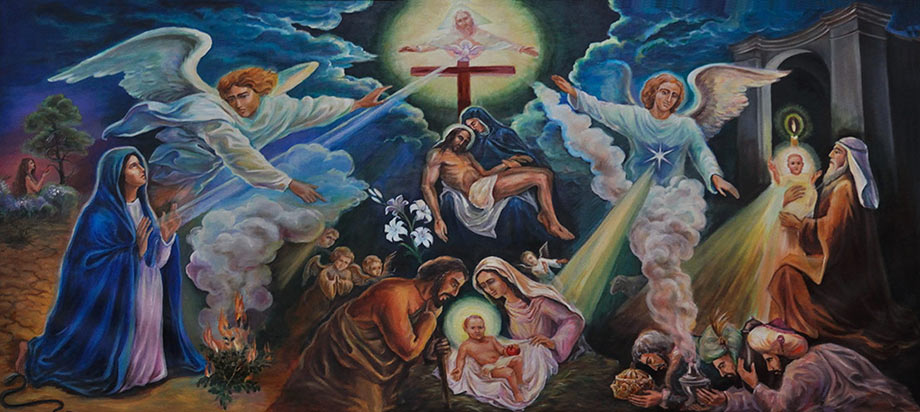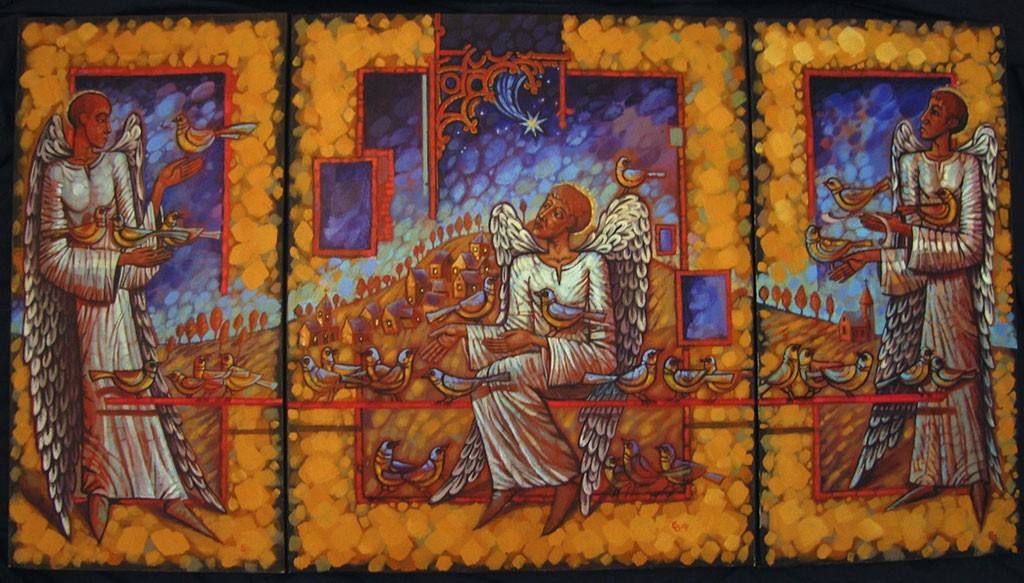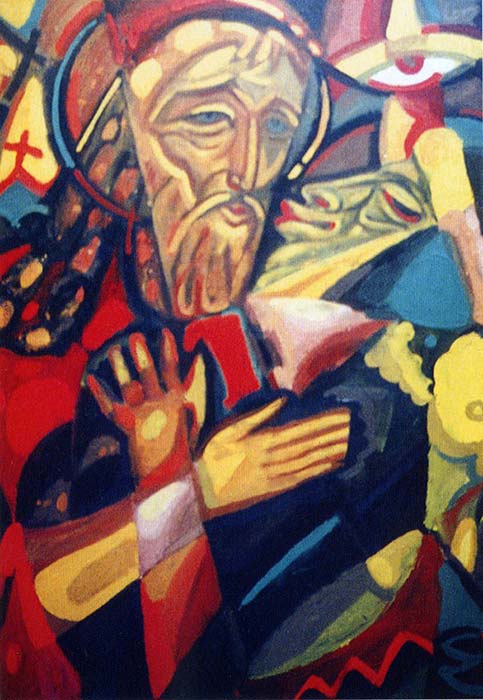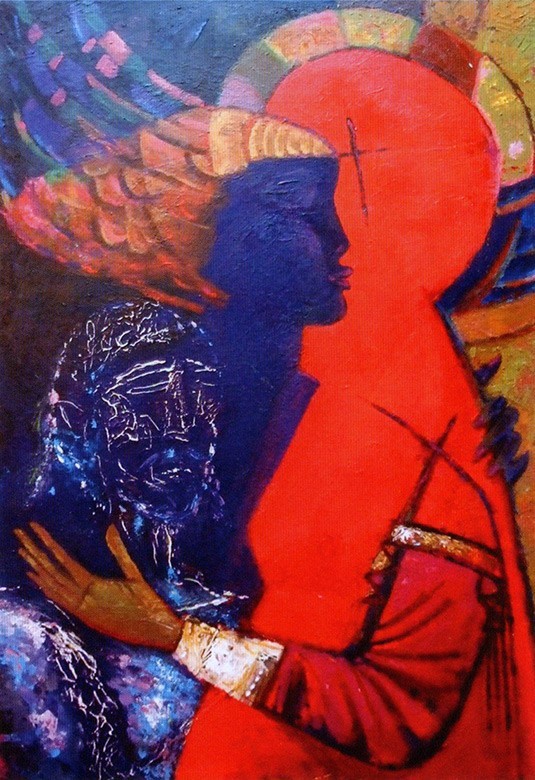Our life is so multifaceted and diverse that it is simply impossible to cover all aspects. However, there is such a wonderful part of it, without which it is difficult to imagine a modern person. It is the oldest and perhaps the most interesting of all aspects of life. These are myths, very diverse and unusual. Today, there are so many variations and types of them that it seems simply impossible to cover them all. However, I tried to do this on the example of the work of Vitebsk artists in 1995-2010.
Hey! This text has been translated into English using automatic Google translation. So I apologize for the inaccuracies in the text. The original in Russian can be seen here
All material is presented in four articles devoted to different directions in modern myths, respectively:
- Religious and mythological themes in the painting of contemporary artists of Vitebsk.
- Biblical subjects in the works of Vitebsk authors.
- Pagan themes in the works of artists of Vitebsk.
- Mythological subjects in the author’s interpretation.
This study was carried out by me in 2009-2010 as part of my master’s thesis “Mythology in the work of contemporary artists of the Vitebsk region”, which was successfully defended in the same year.
Biblical subjects in the works of Vitebsk authors.
Among all the paintings created by Vitebsk artists based on mythological subjects, works created on biblical motives stand out strongly. On the territory of Belarus, among other stories, these are especially relevant, because back in the 10th century, the Slavs adopted Christianity as the main, state religion, and it was then that a nationwide baptism took place. Since then, biblical motifs in art have been spread on the territory of Vitebsk, and as a private and more specific, Orthodox Christianity.
Often, such a widespread distribution of Christianity among believers is also reflected in the work of artists. As a rule, among the paintings of many authors, we also find those whose compositional construction and the main idea reflect precisely Christian motives. There are many such works, but there is one at a time. But some artists, such as Mikhail Yermashkevich, work exclusively with biblical myths. Among his paintings, we find the famous story “Saint Dominic”, which is presented here in a new way to the viewer. His original name is Santo Domingo de Guzmán or Domingo de Guzmán Garces. He was born in 1170 in Caleruega (Spain), and died in 1221 in Bologna (Italy). He is the founder of the Order of the Brothers Preachers, or the Order of the Dominicans. Saint Dominic is depicted traditionally in a white tunic of a Dominican monk and a black cloak. His iconographic symbols are also present – a lily, a star above the forehead, a book, the founder’s (patriarchal) cross.

There are two significant works in his work, one of which is “ET VERBUM CARO FACTUM EST” (And the word became flesh). In it, the main thing is the transfer of the main idea through the construction of figures in the composition. The artist in the picture combines several biblical myths, combining them into one idea. The work presents Easter and the Nativity of Christ, the mystery of the incarnation and resurrection, the annunciation and bow to the sage. We see all this on one canvas..

His other painting “HOC EST ENIM CORPUS MEUM” (For this is my flesh) is built on the same principle. In it, Mikhail Yermashkevich contrasts Jewish and Catholic Easter. There is a crucifix in the center of the work, because Jesus opened heaven through sacrifice. On the left we see a biblical story – the exodus from Egypt and the so-called waters of baptism. The lamb, as a prototype of the sacrifice of Christ and the shed blood, is also depicted to the left of the crucifixion. On the right, you can see an empty coffin and a rolled stone. This is how the author, using classical biblical myths, conveyed his vision and understanding of Christianity in his works.

Yermashkevich also recreated in a series of 13 small works under the general name “The Way of the Cross” the legend from the New Testament about Jesus carrying the cross and his subsequent crucifixion, reflecting in this project the pain and anguish of the great messiah. This series is a classic example that has been used since the Middle Ages to convey biblical stories in churches, when illiterate people could get acquainted and learn this or that covenant through the images and pictures depicted on the walls of the church. In the same way, a series of works by Ermashkevich dedicated to the Way of the Cross was built. All works are in the form of a circle, so here you can see how the artist fits this or that plot or composition into this format, because. it has its own characteristics. The author used the image of Christ in almost every work from the series. This allowed the artist to focus on conveying the features of the internal state and mood of the main character at one time or another. We can see the pain and suffering embracing Christ while he was carrying the Cross, and the next moment a picture appears in front of us, in which the mother is already mourning the deceased, and so this or that image pops up in front of us, a beautifully conveyed state of the soul in difficult times. All works have a rather dark color scheme, which emphasizes the complexity of the current situation.

Oleg Skovorodko (“Angels and Shepherds”), Dmitry Gorolevich (“Apple Savior”), Sergey Sotnikov (“Apple Savior”), Viktor Shilko (“Prayer”), Anatoly Izoitko (“Presentation”, “Christmas Dreams”), Eduard Galustov and other authors. These works are very different and in their own way convey the spirit of the old biblical myths. For example, Oleg Skovorodko in his work “Angels and Shepherds” conveys the flight of angels through abstract and symbolic images of shepherds. The figures are conditional and have a large symbolic component. In the work the author uses separate stylized elements of the landscape. The whole background is conditional and helps to bring to the fore the main acting figures. Color is also conditional and reflects the features of each object. This style used in this painting, based on a combination of color spots, is very different from the style of Mikhail Ermashkevich’s work, where the focus is on figurative composition with realistic characters.






And, for example, in the works of Sergei Sotnikov both color spots and a general idea are combined, expressed through a figurative and more realistic construction of the composition. In his painting “Apple Spas”, as well as in the work of Dmitry Gorolevich “Apple Spas”, we see an abundance of apples and unusual faces. The artists managed to convey the general mood characteristic of this holiday. Their work is similar to each other in terms of internal installation and spirit. From the Bible, the Transfiguration of the Lord, described in the Gospels, the mysterious transfiguration, the manifestation of the Divine majesty and glory of Jesus Christ before the three closest disciples during prayer on the mountain. This is a holiday of the Christian church (the Transfiguration of the Lord God and our Savior Jesus Christ, in the Russian folk tradition is also called the Apple Savior or the Second Savior). This event is reported by all the evangelists except John (Mt. 17:1-6, Mk. 9:1-8, Lk. 9:28-36).


But on another canvas by Sergei Sotnikov, “The Abandoned Ark” we see an interweaving of strange elements that, on the whole, make up an unusual frame. This suggests an analogy with the “Noah’s Ark” from the biblical mythology of the Old Testament. The work uses an unusual method of conveying what is desired on canvas, when strange constructions and ruins are created with the help of strokes and work with a palette knife. The artist, using this technique, created the image of an abandoned ark in the picture. This is how, using examples, you can see that the author weaves the idea, the overall composition and the technical methods of transferring individual elements into a single whole on the canvas.
The work of Anatoly Izoitko “The Presentation” is also very interesting. The Presentation of the Lord (lat. Praesentatio Domini – Presentation) is a Christian holiday celebrated in Catholicism, Orthodoxy and Lutheranism. In Orthodoxy, it is revered as one of the twelfth holidays. The meeting symbolizes the meeting of the Old and New Testaments. It is celebrated on February 2 (in churches using the Julian calendar – February 15). Two figures, symbolizing the Old and New Testaments, are uniquely found in the picture. A girl floating in the air, like a ghost, is the Old Testament. When the bright and fresh figure of the second girl symbolizes the New Testament and the new time.

Biblical motifs have always been so attractive that the authors constantly turn to them, leaving landscapes and still lifes aside. But, for example, the work of Osipov’s Chalice can be called a mythological still life, which is dedicated to a Christian ritual subject. This goblet was also depicted in Leonardo da Vinci’s fresco The Last Supper. If you look at Osipov’s creative works in general, for example, such as Before the Chalice, To Faith, Golden River, you can see that the facets of the Christian faith are revealed in a new way. For example, in the work “Golden River”, the author depicts the temple inside a vertical red stripe and, even more symbolically, the dome of the church is on fire. All together the composition of the temple and the fire on its top is a burning candle. Such allegorical transfers of one image to another are characteristic of the entire work of this artist. For example, in the painting “To Faith”, Osipov uses the image of a saint with outstretched arms as the basis for creating the symbol of the cross, as the main symbol of the Christian faith. This handling of images and symbols is not new and is part of modern art, which we can see in the works of other artists.




A large number of works by Nikolay Dundin are devoted to the religious myths of Christianity. Take, for example, “Kiss of Judas”. The master uses a composition of two images: blue and red. The latter refers to Jesus Christ. The proof of this is a small cross depicted near the head, a halo around it, and the very color of the figure. This color is warm, hot and symbolizes the warmth and kindness that comes from Jesus Christ. Under the second, blue, image, the author depicts Judas. He is in blue robes, which means, in this context, coldness and betrayal. But the most important thing is the facial expressions. Jesus Christ at work is depicted as kind, bearded and trustworthy when


In such paintings by Dundin as “The Kiss of Judas”, “The Last Angel”, “Mary”, “The Way of the Cross”, “Messenger” we see well-known scenes from the Bible. All of them belong to the New Testament. For example, in the work “Mary”, the author shows the legend of the immaculate conception of Mary, after which Jesus Christ was born. “Virgin Mary…in Christian religious and mythological ideas, the earthly mother of Jesus Christ, a Jewish virgin who miraculously gave birth without destroying her virginity”. This plot is traced through a series of successive images-symbols. The first of them is Mary – this can be seen from the halo around the head and the display of a pregnant woman. The second symbol is a dove flying towards a woman. At the bottom of the work are displayed faces resembling saints. The whole work is written in an expressive manner and in red and yellow colors. This speaks of the brightness, lightness and unusualness of the event. The entire work is written in a figurative style with a realistic focus. And the painting “The Way of the Cross”, in contrast to the work “Mary”, received a more abstract basis. The picture is a set of various geometric elements of red, yellow and blue tones that make up an integral composition. In the center of the work is depicted Jesus Christ, carrying a cross on his back, which divides the canvas in half. In the lower part we see a figure with a pointing, condemning finger. At the top are three crucifixes and groups of mourners. Nikolai Dundin in his works created unusual images and a new reading of famous stories from Biblical myths.



Biblical stories are also reflected in the paintings of Vitebsk artists. Such images are present in the work of almost every author. Therefore, we can talk about the widespread prevalence of this theme of mythological plots.



